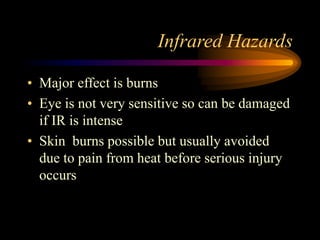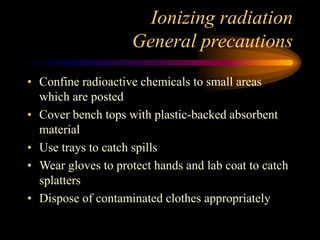This document summarizes various radiation hazards. It describes the characteristics and effects of different types of radiation including ultraviolet, visible, infrared, radiofrequency/microwave, lasers, ionizing radiation, and provides safety precautions for each. Specifically, it notes that UV radiation can cause eye damage and skin cancer, lasers require special precautions due to their intensity, and ionizing radiation can damage tissues and DNA leading to cell death or mutation and potentially cancer if exposure limits are exceeded.













![Regulatory mandates
on ionizing radiation
• Nuclear Regulatory Commission
occupational standard (10 CFR 20) is 5
rems/yr for whole body radiation. [Note
that a lifetime exposure to 5 rem total is
thought to shorten life by 1-3 weeks.]
• Standard for nonwork environment is 170
mrem/yr.](https://image.slidesharecdn.com/radiation-240330173904-9fd2610e/85/radiation-hazards-PowerPoint-presentation-14-320.jpg)

